Endurance training for MMA is an often-misunderstood concept. Traditionally, fighters will hit the roads as their sole form of endurance training to prepare for fights. But is this going to maximize performance in the cage and why might this approach not work?
What Is Endurance Training?
In short, endurance training is a term most coaches commonly use to describe steady-state aerobic exercise to develop the aerobic energy system, not the anaerobic energy system.
Aerobic exercise typically refers to any physical activity that uses large muscle groups and can be maintained during steady-state exercise. For those unfamiliar with the term "steady state exercise,'' it simply refers to an exercise intensity that results in a relatively constant heart rate, breathing, oxygen consumption, and blood lactate levels.
You can maintain this form of aerobic exercise at a continuous rhythmic pace for a prolonged period [1]. In other words, you can perform steady-state exercise for hours. Still, there are other useful training methods for MMA fighters!
Jogging, swimming, and cycling at moderate intensities for long durations with a near-constant heart rate and movement velocity are a few examples of steady-state exercise that relies primarily on the aerobic energy system.
The aerobic energy system uses oxygen to extract energy from food to produce adenosine triphosphate [2], or simply "ATP." Whenever you see the term "ATP," all you need to remember is it refers to a high-energy molecule your body uses as fuel because the cells of your body cannot use blood glucose directly as a fuel source [2].
This is why the aerobic energy system will extract energy from food to produce ATP during cellular respiration. This necessary process occurs within the mitochondria structures of the cells [2].
It is also important to remember that during this cellular respiration process, the body's cells will discard waste products, carbon dioxide (CO2), and water [2].

How to Dominate Every Fight with Raw, Explosive Power No One Can Match
Discover the underground blueprint that has quietly turned MMA hopefuls into legends, using nothing but sheer, brute force and bulletproof conditioning techniques.
Your body produces much more CO2 as exercise intensity increases [3], which is why you often see MMA fighters breathing heavily after intense striking and grappling exchanges. Simply stated, the amount of CO2 you produce directly influences your breathing at rest and during exercise [3].
How Long Does It Take For The Aerobic Energy System To Turn On?
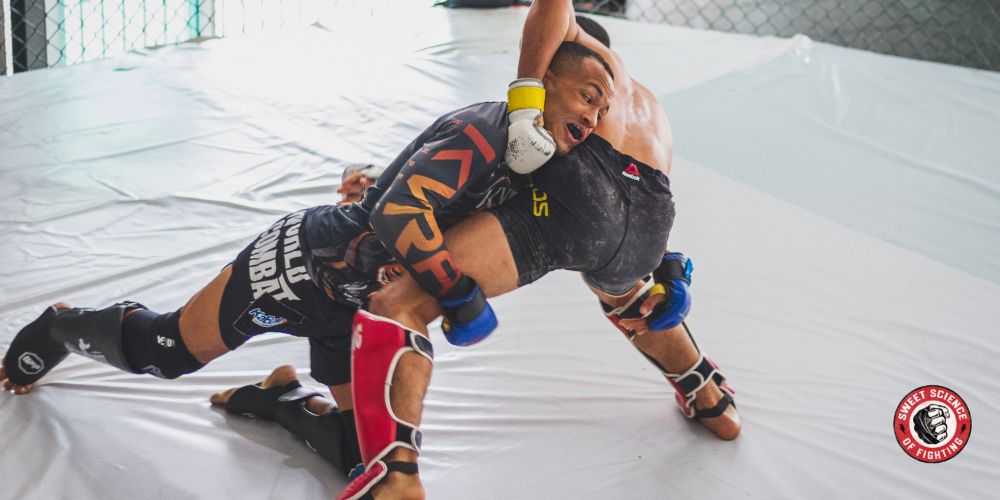
Most of the time, there is a significant delay before the aerobic energy system can produce a significant amount of ATP. Notice the keywords "most of the time."
The vast majority of sports performance coaches will tell you that the aerobic energy system is not the primary source of energy production until 1-2 minutes of exercise. Well, suppose you go for a run at a sufficient intensity. In that case, 1-2 minutes is a reasonable estimation most of the time [2][4].
However, it is important to understand that you can turn on the aerobic energy system much faster during very intense exercise, which many sports performance coaches do not understand due to a lack of biochemistry training.
For example, if your apartment begins to collapse from a falling meteor and you start running for your life, the aerobic energy system can contribute 70-100% of the ATP to fuel your body in approximately 30 seconds [4].
In contrast, if you go for a prolonged moderate-intensity long-distance run, it is reasonable to assume that the 1-2 minute mark will be the point aerobic metabolism provides most of the ATP your body needs. But this depends on your cardiorespiratory fitness and other factors [2][3][4].
In contrast to the aerobic energy system, the anaerobic energy system describes exercise conditions during which the body produces ATP without using oxygen [2].
It is essential to understand you can only perform that very high exercise intensity for brief periods, and they rely on anaerobic energy systems for ATP [2][4]! In addition, the anaerobic energy systems must rely on aerobic energy systems for resynthesis [2][4].
Whenever MMA athletes perform explosive actions such as punching and kicking combinations, anaerobic energy provides the vast majority of the necessary ATP to fuel high-intensity movements.
The anaerobic energy system consists of two separate systems. For whatever reason, the immediate anaerobic energy source is referred to by the following three names: the phosphagen system, the alactic anaerobic system, and the ATP-PCr system [2][4].
The ATP-PCr will produce ATP during short bursts of approximately 10-15 seconds before being depleted without the production of lactate, which is why it is often referred to as alactic [2][4].
In contrast, the anaerobic lactic system, or glycolysis, is the primary source of anaerobic energy after the ATP-PCr is depleted at approximately the 10-15 second mark [4]. Glycolysis typically lasts anywhere from 30 to 90 seconds [4].
This glycolysis produces ATP by converting carbohydrates to lactate. It is not limited by carbohydrate stores in the muscle but by increased acidosis within the muscle because of increased hydrogen [4]. Not the blood lactate that is simultaneously ejected from the exercising muscle [2]. This is another crucial topic that MMA fighters need to understand.
How Long Does It Take For The Anaerobic System To Activate?
It is important to understand that during intense short-term exercise, both anaerobic and aerobic energy systems are quickly turned on to rapidly produce ATP to meet the energy demands of the exercising muscles. Both energy systems produce ATP at all times, but at varying degrees that depend on the exercise intensity [2].
During intense exercise, the demand for ATP may increase 100-fold in less than a second [2][4]. This occurs during short bursts of explosive, high-intensity activities such as striking and grappling exchanges that you frequently see in MMA fights.
Get James Ramseys New Book!
Also, blood lactate levels will increase dramatically during these short bursts of explosive, high-intensity activities as the ATP-PCr system is depleted. This clearly demonstrates why developing anaerobic energy systems is critical for MMA fighters!
Keep in mind that while the aerobic energy system can produce an enormous amount of ATP, it is much slower in producing ATP than the anaerobic energy system [2][4].
In contrast, the anaerobic energy system is limited by the amount of ATP it can produce in a single exercise bout. It relies on the aerobic energy system to replenish in between these explosive bursts that occur during striking and grappling exchanges [2][4][5].
How the aerobic energy system supports the anaerobic energy system is another important topic for MMA fighters.
Why Is Endurance Important For MMA
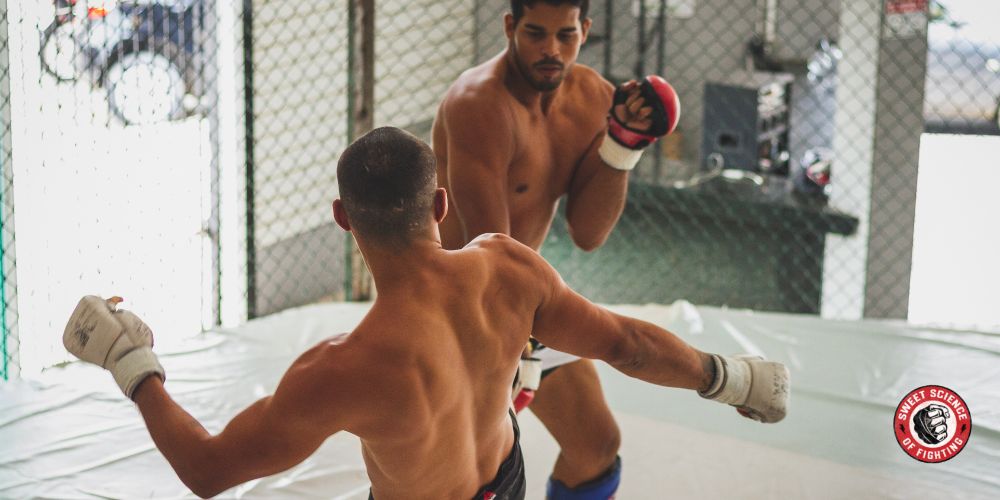
To understand why endurance is essential for MMA, we need to define MMA endurance in a manner that accurately describes the physical demands placed on fighters during their MMA fights.
Based on the physical demands of the sport, I define MMA endurance as the physical ability of an MMA fighter to repeatedly perform short bursts of explosive, high-intensity activities without significant decreases in maximal force or power production throughout the competition.
In other words, MMA endurance is the ability of a fighter to repeatedly perform all of the necessary striking combinations and grappling exchanges at high intensities and in an explosive manner throughout MMA fights!
MMA fights are scheduled between 9-15 minutes for amateur fighters and 15-25 minutes for professional fighters. All MMA fighters must perform these short bursts of 8-12 seconds on multiple occasions during the fight [5].
Based on this information, endurance for MMA fighters requires these athletes to develop both the aerobic energy system and the two anaerobic energy systems. You must remember traditional endurance training will not properly develop the two anaerobic energy systems you need to succeed in MMA [6]!
Endurance Training For MMA
If your coach tells you that running 6-8 miles a day is all you need to prepare for a fight, find a new coach as soon as possible!
Sadly, many coaches who have never studied exercise biology will use expressions like "work on your endurance and go run for a couple of hours."
All while completely ignoring combat sports require well-developed anaerobic energy systems to complement the aerobic energy system. No one at the UFC Performance Institute or other world-class training facility ignores these facts!
While long-slow distance runs performed every day will improve your aerobic energy system, more is needed to adequately develop the two critical anaerobic energy systems required for high-intensity explosive bursts of activities such as intense striking combinations and grappling exchanges. This topic is not up for debate because it is well-established by sports performance science.
Detailed scientific analysis of MMA fights has found that fighters must perform short bursts of explosive, high-intensity activities that last approximately 8-12 seconds. These activities rely upon the two anaerobic energy systems [5][6].
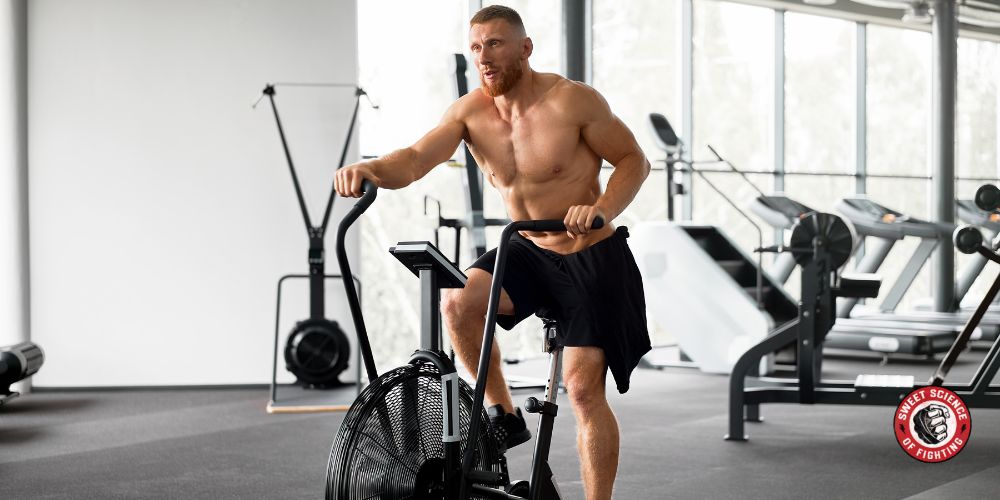
Always remember that these short bursts of explosive movements depend on the anaerobic energy systems because the aerobic energy system cannot provide energy fast enough [4]. These "short bursts" are followed by lower-intensity activities that are two to three times longer.
During this period, the aerobic energy system replenishes the two anaerobic energy systems [5]. This coordination between the aerobic and the aerobic energy systems is what I think of when I hear coaches discussing "endurance for MMA!"
Rather than wasting your entire MMA conditioning time performing steady-state aerobic training such as running, bicycling, or swimming for hours each day and neglecting your anaerobic energy systems, it would be a much better idea to utilize the science of high-intensity interval training or HIIT.
Of course, a base of steady-state aerobic exercise underpins anaerobic performance within MMA. However, it can't be the only thing you do.
There are five versions of HIIT that you can use to prepare for MMA fights properly, and I will provide a detailed description and a few examples for each. Keep in mind that MMA fighters get more than enough low to moderate-intensity training while drilling both striking and grappling techniques at moderate intensities. This is why an emphasis should be placed on HIIT for energy systems development.
Before I go into the specifics of HIIT for MMA fighters, do you remember when I said at high-intensity exercise that CO2 dramatically increases? Does it directly influence how heavy you are breathing [3]?
If you are breathing intensely and deeply, you are exercising at high intensity, and your body is exhaling the CO2 to minimize the increased acidosis in your blood [3].
f you are ever wondering if your exercise is within the moderate or the heavy intensity domain without expensive laboratory equipment, pay attention to how heavy you are breathing. If you can't hold a conversation with someone, it's likely in the heavy-intensity domain!
Long HIIT Interval Workouts
These are typically performed between 2-8 mins in duration with an intensity of 80-95% of your peak heart rate with 1-3 mins rest [6]. This version of HIIT is used to develop the maximal capacity of the aerobic energy system.
It is best used early on in a fight camp [6]. I recommend 3-minute rounds for amateur fighters with one-minute rest for 3 to 5 rounds and 5-minute rounds for professional fighters with 1-minute rest for 3 to 5 rounds depending on the scheduled MMA fight.
Side note, heart rate is not always an accurate method to gauge intensity. Still, it will provide a rough estimate. So, you must combine your heart rate data with a personal rating of perceived exertion or simply "how intense it feels."
Having said that, purchasing blood lactate strips is a good idea to accurately determine how intense your exercise is. The recommended range for this intensity of training is 8-12 mmol/L for this type of training for MMA fighters [6].
Remember that hydrogen is ejected simultaneously with lactate from the exercising muscles [2]. The hydrogen produces an acidic environment during exercise [2], which is why you can use blood lactate measures to determine how hard you exercise. Also, it is important to note that lactate is an important fuel source during prolonged MMA competitions.
Exercise | Work | rest | Intensity |
|---|---|---|---|
Striking or Grappling Drills | 2-8 mins | 1-3 mins | 80-95% MHR |
My preferred method is escaping a bottom position in grappling and quickly restarting under another disadvantaged position once I have escaped to the standing position. However, you are only limited by your imagination to create training scenarios, and you must address the strengths and limitations of each MMA fighter when utilizing this method!
Short HIIT Intervals
This consists of brief exercise bouts that may last from 10 – 60 sec at 100 – 120% vV̇O2max with 10 – 60 sec rest [2].
Remember my analogy of the building collapsing because of a meteor hitting the building? That is the ideal intensity for this version of HIIT. These are used to develop the previously described alactic and lactic anaerobic energy systems and are critical for developing the ability to produce high-velocity movements during intense striking and grappling exchanges [5][6].
Because these workouts produce an enormous amount of fatiguing metabolic by-products, they should be a priority early in an MMA fighter's training camp to help prevent overtraining [6].
Exercise | Work | rest | Intensity |
|---|---|---|---|
Explosive striking combinations on heavy bags. | 30 sec | 30 sec | RPE 8 |
Explosive wrestling drills with all activities performed at maximal intensities. | 20 sec | 40 sec | RPE 8 |
Once again, determine your needs as an MMA athlete when determining which methods are most appropriate.
Repeated-Sprint Training
As the name implies, this method typically utilizes sprints for 3-10 seconds at max intensity exercise and is followed by 15-60 seconds of rest and is repeated for 12 sprints [6].
This is used by many MMA coaches to improve the buffering capacity of the exercising muscles. This helps minimize blood acidosis increases that dramatically influence fatigue [6].
BEFORE YOU PLAN MULTIPLE BOUTS OF SPRINTS, remember that the adaptations occur in the skeletal muscles performing the work [7]. In other words, if you only run, the adaptations will predominantly occur in your legs. This would not be a wise strategy for any combat athlete! All MMA fighters use their arms and legs throughout the fight!
Exercise | Work | rest | Intensity |
|---|---|---|---|
Rowing or Airdyne bike sprints | 8 sec | 20 sec | Maximal |
Pummeling | 10 sec | 30 sec | Maximal |
Use anything that incorporates the whole body for brief periods at maximal intensity! However, it may be appropriate to alternate between upper-body and lower-body exercises with this protocol.
Sprint-Interval Training
This method uses sprints for 30 seconds at maximal intensity with 60 to 90 seconds rest between each sprint for 3 repetitions (one cycle). Followed by a 3-minute rest period after each cycle of sprints has been completed. You may perform each cycle for four sets [6].
Although this sounds similar to the previous version of HIIT, it is focused on developing the alactic energy system, or ATP-PC. It provides the energy for brief, explosive striking combinations and grappling exchanges performed at maximal intensity [6]!
It is also important to remember that a highly-developed aerobic energy system replenishes this alactic energy system between exchanges [6]. This method of HIIT is to be used at later stages of a fight camp and with lower volume to prevent over-training leading up to an MMA fight [6]!
Exercise | Work | rest | Intensity |
|---|---|---|---|
Striking drills | 30 sec | 60 sec | Maximal |
Grappling Drills | 30 sec | 90 sec | Maximal |
Fight-Based HIIT Drills
you will often hear this training method referred to as "shark tank training." It utilizes striking and grappling scenarios to try and simulate situations that typically occur during MMA fights. During these HIIT drills, MMA fighters have "fresh" training partners rotate every minute for a 1-minute training time for the round [6].
During these intense 1-minute periods, MMA fighters may focus on takedown defense, takedown offense, grappling escapes, wrestling scrambles, and striking combinations mixed with sprawls and counter takedowns. Your imagination only limits you.
These drills simultaneously develop aerobic and anaerobic energy systems [6]. However, it is imperative to note that metabolic fatigue can impair the quality of the fighters' techniques. In other words, you can become fatigued quickly.
Your training will utilize "sloppy technique" that can negatively affect technical fighting skills. So these drills require monitoring by a skilled coach to determine when you are "too fatigued" to train with any quality of technique [6]. As is the case for the previous 4 methods of HIIT, how you use this conditioning method is highly individualized.
Exercise | Work | rest | Intensity |
|---|---|---|---|
Shark Tank | 3-5 min | Variable | Maximal |
How Do UFC Fighters Train Endurance?
This is a complicated question because every MMA athlete adapts differently, and many have unpredictable fight schedules that further complicate their training organization.
Ideally, you would progress from versions 1-5 in a pre-planned sequence leading to a fight, but this is not always possible because of unpredictable fighting schedules. Also, you always want to remember that in any large group of MMA fighters, they typically have different physiological capabilities and limitations.
This is why performance testing is crucial. The research suggests that the physiological adaptations that occur as a result of specific HIIT training happen in as little as 6-9 training sessions when performed two or three times a week over a 3-4 week period [6].
For those familiar with undulating periodization, you may use a similar training philosophy and blend the 5 versions of HIIT during sessions performed 2 or 3 days throughout a training week.
However, like everything else in sports performance, there is variability among different MMA fighters. This is why you need an educated coach who properly organizes your training. To prescribe specific MMA tests to determine your strengths and limitations, and who thoroughly understands how to monitor MMA fighters to ensure that they progress as a result of their training!
Are MMA Fighters Endurance Athletes?
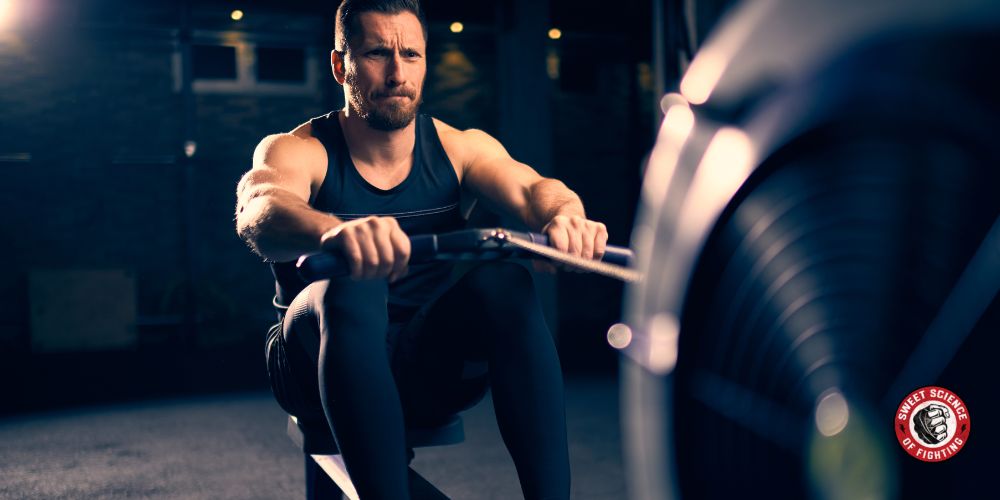
As previously stated, MMA fighters are required to have highly developed aerobic energy systems and anaerobic energy systems to be successful. Because traditional "endurance training" is typically focused on developing the aerobic energy system, I would not describe MMA fighters as purely traditional endurance athletes.
I refer to MMA fighters as hybrid endurance athletes because elite-level fighters tested at the UFC Performance Institute have reported maximal aerobic values that are as high as college distance runners. In addition, elite-level MMA fighters also have highly-developed anaerobic energy systems, and the UFC performance center has demonstrated that.
Summary
To succeed, you must develop aerobic and anaerobic energy systems by utilizing MMA-specific training HIIT to supplement your sparring and grappling training. In addition, MMA fighters need to leave the old school 6-8 mile daily runs in the past because they are not supported by sports performance research.
In my opinion, as a long-time MMA coach, MMA fighters get more than enough low and moderate-intensity exercise during the many hours of drilling various grappling and striking drills and techniques
Biggest, Baddest Gas Tank In Just 8 Weeks
Dominate The Cage is specifically designed to develop elite level MMA cardio based on your easy to implement test results
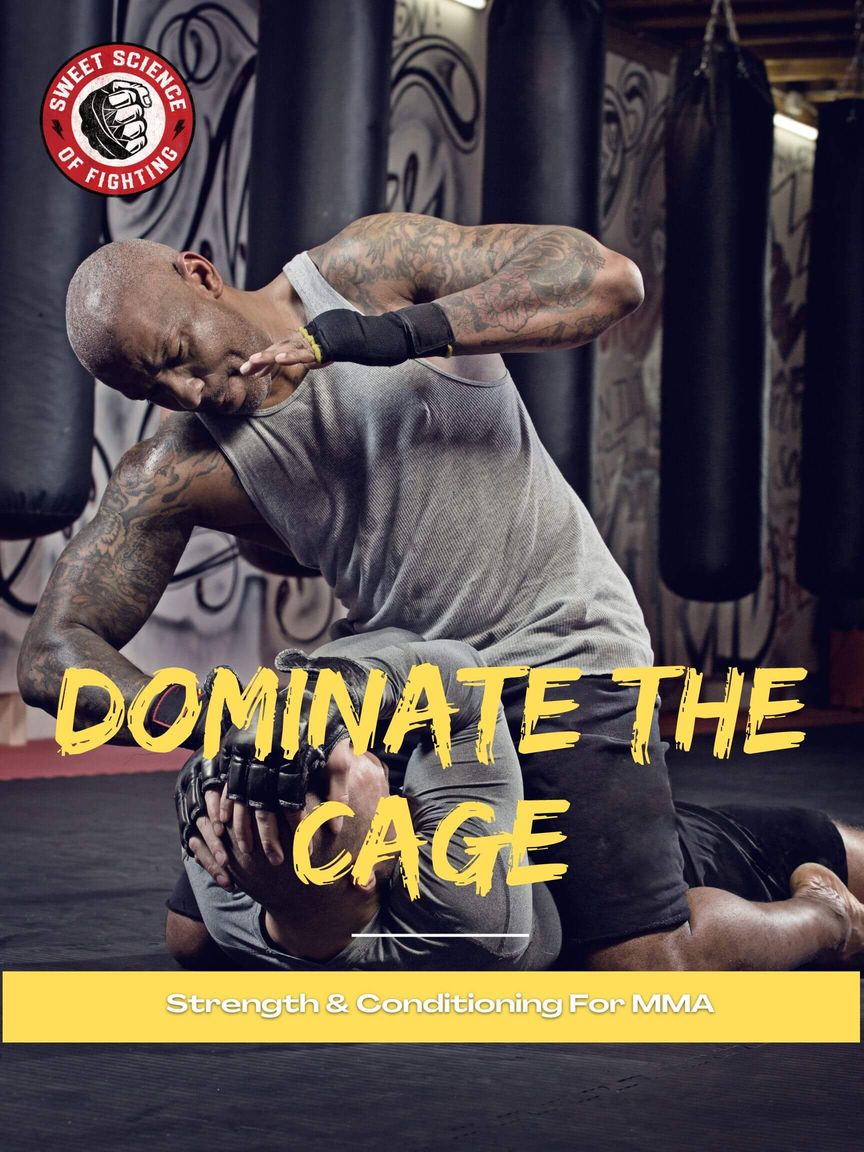

References
1. Hofmann, P., Bunc, V., Leitner, H., Pokan, R., & Gaisl, G. (1994). Heart rate threshold related to lactate turn point and steady-state exercise on a cycle ergometer. European journal of applied physiology and occupational physiology, 69(2), 132-139.
2. Hargreaves, M., & Spriet, L. L. (2006). Exercise metabolism. Human kinetics.
3. Poole, D. C., & Jones, A. M. (2012). Oxygen uptake kinetics. Compr Physiol, 2(2), 933-96.
4. Hargreaves, M., & Spriet, L. L. (2020). Skeletal muscle energy metabolism during exercise. Nature Metabolism, 2(9), 817-828.
5. Ruddock, A., James, L., French, D., Rogerson, D., Driller, M., & Hembrough, D. (2021). High-intensity conditioning for combat athletes: practical recommendations. Applied Sciences, 11(22), 10658.
6. Laursen, P., & Buchheit, M. (2019). Science and application of high-intensity interval training. Human Kinetics.
7. Holloszy, J. O., & Coyle, E. F. (1984). Adaptations of skeletal muscle to endurance exercise and their metabolic consequences. Journal of applied physiology, 56(4), 831-838.

